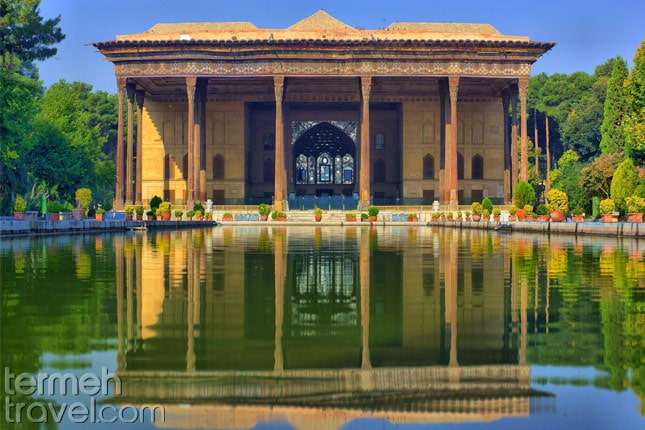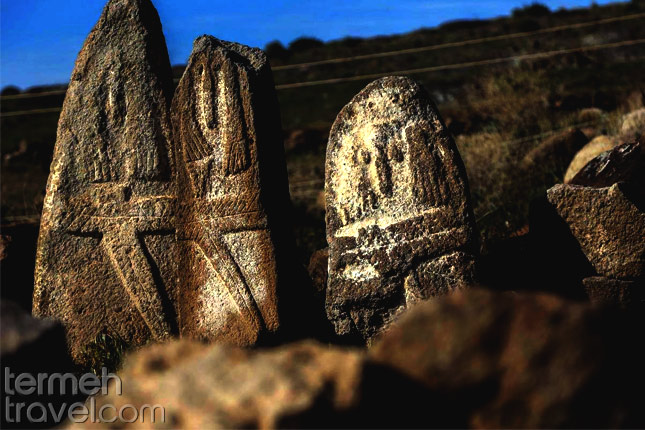Sun rays dance on the trees like chains of sparkles when the butterflies enter the Persian Garden’s gate early in the morning to play with newborn blossoms. The pleasant cool breeze brings the aroma of flowers to you, and the water drops of the fountains pat your face. The crystal water flows inside the stream to meet you at the gate. You can see how the treetops on two sides of the stream touch the sky and feel the puffy clouds.
The angels put every element of the Persian Gardens together to make the utter resemblance of paradise on earth. The structure and design of the gardens are beyond beauty, which makes them one of the essential landmarks of Persian architecture and culture throughout history.
Table of Contents
The History of Persian Gardens
We can find the first signs of Persian Gardens in The Achaemenid period. According to historical documents, Cyrus the Great (the king of Persia and the founder of The Achaemenid Dynasty) demanded to create a garden in order to show his power as the king of the biggest empire on earth to others and to put his tomb inside it. That is why Pasargad was designed and built; however, there are no remains of Persian Gardens around Cyrus’s monument.
Besides Cyrus, we can link the value of Persian Gardens to Zoroastrianism. The believer of Ahura Mazda (The God in Zoroastrianism) and the follower of the prophet, Zoroaster, considered nature as the creation and belonging of Ahura Mazda. Therefore, it has to be kept in its perfect shape, and human beings have to prevent any behavior which can harm it.
By building the gardens, ancient Iranians tried to strengthen their link with nature and please their God. One of the Achaemenid kings called Ardeshir II mentions that “I established this garden with the help of Ahura Mazda, and I ask him to protect the garden and me from all impurities.”
After the Achaemenid Dynasty, Persian Gardens developed more, and the architects got inspired by some of the Islamic features to create phenomenon structures and pure masterpieces, which can be seen today as well.
Persian Garden’s Terminology
If we take a look at historical documents and epigraphs which have remained from about 2500 years ago, we can find the word “Pardis,” which refers to Persian Gardens. Pardis meant paradise or heaven and had been used to refer to vast, elegant gardens. However, due to the combination of Arabic and Persian language, this word is known as Ferdows as well.
What Are the Characteristics of Persian Gardens?
Iranians are known for their artistic spirits and their value toward art. Therefore, by combining spiritual aspects into natural elements and Persian art, they designed highly sustainable, gorgeous, and majestic structures of Persian Gardens.
Sunlight
The first and one of the essential elements in building a Persian Garden is considering the sunlight. The architects needed to pay attention to the sun’s direction and build the rest of the gardens. The sunlight had a major effect on placing the stream, planting the trees, and building the mansion inside the garden.
Water
Another significant element that plays a major role in establishing a Persian Garden is water. Water is one of the respective elements in Zoroastrianism. They believed that water is purifying and life-giving to other creatures. Therefore, the architects used to build Persian Gardens near a Qanat or aqueducts to have access to the water and use it to balance the temperature of the garden as well.
Trees and Flowers
The plants that exist in Persian Gardens can be varied based on the difference of the climate between cities of Iran, so the architects needed to use the local plants in different gardens. However, the usage of cypress and pine is similar among all the Persian Gardens. These two trees are the symbol of endurance in the Persian culture.
The flowers in the gardens have different purposes. Planting them can make the gardens beautiful and fragrant; also, they can be used for making jams. Various rose bushes are the most common flowers in Persian Gardens; however, by planting oleander flowers, they wanted to keep bugs away.
Mansions
Almost all of the Persian gardens were used by the royal family during long holidays when they wanted to enjoy their time the most and be in nature. Therefore, the mansions needed to be built inside the gardens and designed elegantly.
The most eye-catching feature of these mansions is the tile and plaster works that can represent the delicacy and beauty of Persian art.
The building of Kusks or Kushk in Persian Gardens is spectacular. These pavilions are built in open areas to support a geometric roof with columns. Both columns and the roof are designed with Persian and Islamic patterns and colored beautifully.
Based on the different climates, the structure of these mansions can vary.
Why Are Persian Gardens Significant?
These magnificent gardens are more than just beautiful. Although these paradises are fantastic to explore, they are truly remarkable attractions for getting to know the Persian culture. Their diversity and design are quite unparalleled; therefore, they are valuable in terms of their architectural design. Nine of these amazing gardens are in Iran’s UNESCO World Heritage list, which makes them even more interesting to visit.
What Are the Most Fantastic Persian Gardens You Must See in Iran?
Persian Gardens all around Iran share many similar features to display the connection between human beings and nature, along with the concept of the beauty and order of the universe.
When you open the gate and enter the garden, there is a sidewalk in front of you, which is surrounded by green trees on two sides and a stream in the middle of it. You can look around and see different flowers make you stunned with their perfect aroma. You can continue your way and see an outstanding mansion in front of you that every detail of it can play with your imagination.
Although this is the overall picture of a Persian Garden, each of this UNESCO heritage is unique in their own way.
You can travel to Shiraz and visit the mother of Persian Gardens, Pasargad, and then, go to the Eram, to see how the fragrance of bitter oranges’ blossoms can enchant you.
Although Delgosha and Afif Abad Gardens are not on the UNESCO list, visiting them is definitely worth it.
You should visit Shazdeh Garden in Kerman, Dolat Abad, and Pahlavan Pour Garden in Yazd, and Fin Garden in Kashan to experience the most pleasant weather there. Although these cities have a high temperature, the smart usage of water and windcatchers helped to balance the heat.
Traveling to Birjand, located in South Khorasan, you can visit Akbarieh Persian garden and see how Persian architecture combined with some Russian architectural design elements to make perfection.
Chehel Sotoun Palace in Isfahan is another level of beauty with its spectacular architectural design and the combination of color and patterns of its mansion.
By Traveling to Behshahr, Mazandaran, you can find Abbas Abad Persian Garden, which shows you one of the largest Persian Gardens.
You can travel to Iran to have the unique experience of visiting heaven on earth and carry its wonderful memory for the rest of your life, so start planning your trip to Iran now.














Leave a Comment